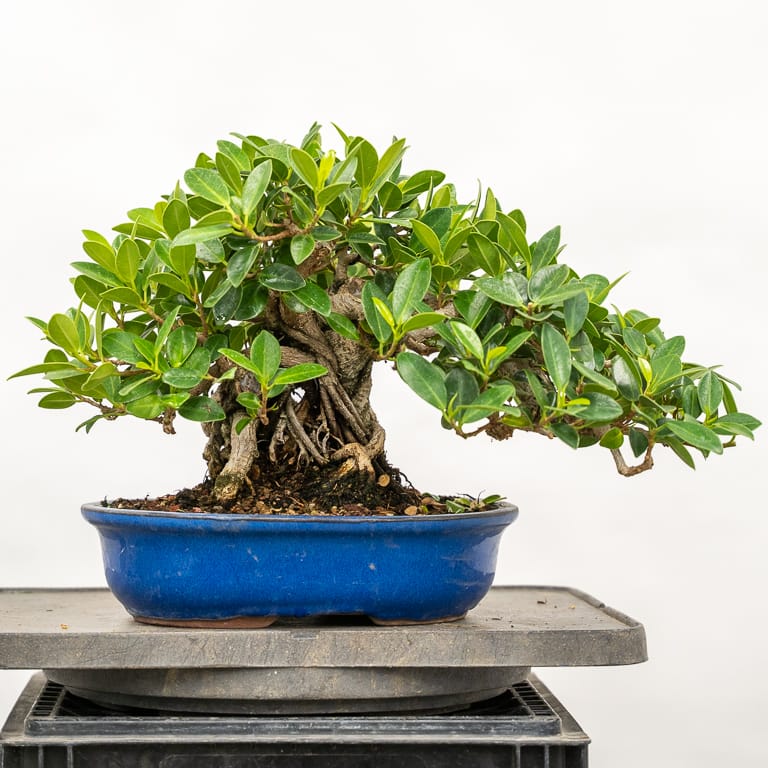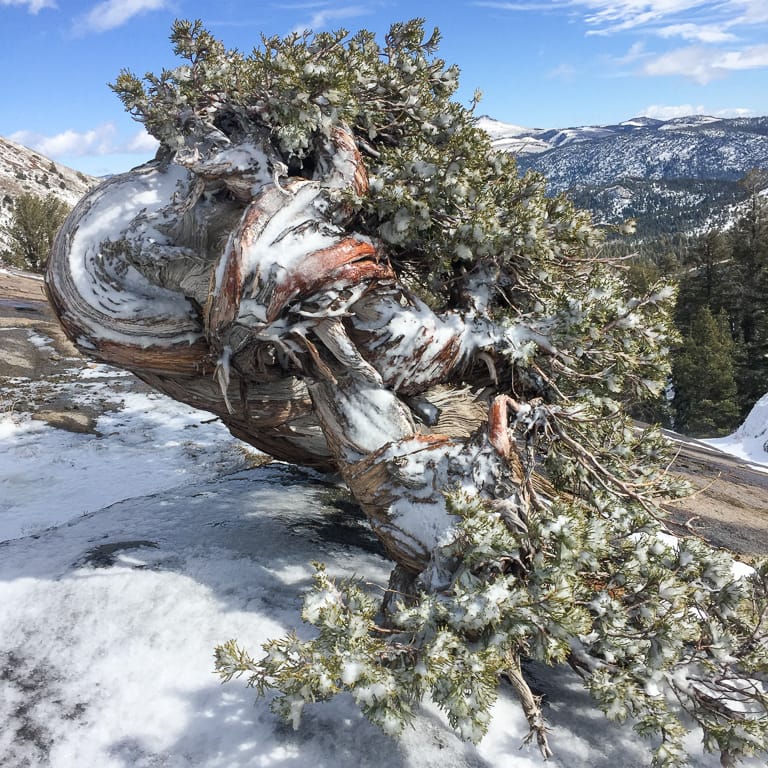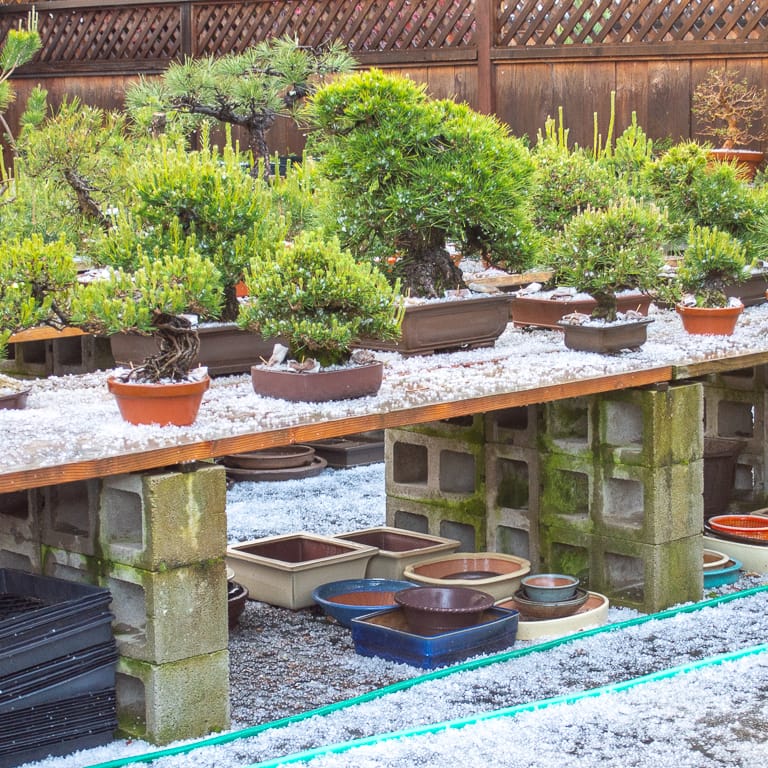Your bonsai might need to be kept out of the weather in the winter, depending on where you live and what kinds of trees you grow. This article will help you figure out which trees need protection and how to give it to them. It will give you an overview of the types of shelter your trees may need as well as winter tree care tips from growers who live in cold climates.
Cold, of course, is relative. In mild winters, where you live, temperatures may not drop below 30 degrees F for more than a few hours at a time. This means that your temperate trees may not need any protection at all.
Temperate species include pines, maples, junipers, and elms, among others. The bulk of coniferous and deciduous species are temperate and can handle varying levels of cold in winter. Many of them need it and will die or not bear fruit if they don’t spend enough time below a certain temperature.
This isn’t the case for tropical or sub-tropical bonsai. These trees, including ficus, premna, jade, and serissa, don’t grow as well when it gets cold. If you keep tropical plants inside all year, they usually don’t need any extra care in the winter. But if you grow tropical bonsai outside in the summer, they will need extra protection when the temperature drops into the 50s (F).
The winter season can be harsh and unforgiving for beloved bonsai trees. Proper overwintering care is crucial to ensure your bonsai survive the cold weather and emerge healthy in spring. This guide covers everything you need to know about caring for bonsai trees in winter, including protection techniques, watering, pest control and more. Implement these bonsai winter care tips and you’ll have happy, thriving trees that continue flourishing for years to come.
Why Winter Care is Essential for Bonsai
Bonsai trees growing outdoors in pots are especially vulnerable in winter for a few key reasons
-
Exposed roots – Unlike trees planted in the ground bonsai roots are not deeply insulated from cold and are at risk of freezing.
-
Limited energy reserves – The restricted root system and small size of bonsai limit storage of nutrients and energy required to withstand extended cold
-
Risk of dehydration – Cold drying winds and frozen soil prevent water absorption by roots, leading to potential dehydration damage.
-
Sunlight deprivation – Shorter winter days and limited light reduce a tree’s ability to photosynthesize and maintain vigor.
Providing cold protection, proper watering, pest management and other care helps mitigate these winter stresses.
Overwintering Tips for Outdoor Bonsai
Here are important tips for overwintering and caring for temperate, deciduous and coniferous outdoor bonsai during cold months:
Allow dormancy before winter storage
-
Let trees experience a few light fall frosts to trigger dormancy before putting in winter storage.
-
Wait too long and new growth could get damaged by cold. Act too early and stored warmth may break dormancy prematurely.
Shelter trees in a cold frame or greenhouse
-
An unheated greenhouse or cold frame helps insulate trees from dramatic temperature swings.
-
Cold frames with insulation and/or heating coils prevent pots from freezing entirely.
-
Ventilate on sunny days to prevent premature spring growth.
Bury potted trees in soil
-
Planting bonsai pots in the ground or burying in mulch insulates roots from freezing.
-
Ensure soil drains well and doesn’t get waterlogged.
-
MARK LOCATIONS so you don’t forget trees in spring!
Wrap or cover pots
-
Wrap bonsai pots with insulation like bubble wrap or burlap.
-
Styrofoam container covers help insulate root balls.
-
Place trees in protected areas away from winds.
Provide modest fertilization
-
Monthly application of half-strength liquid fertilizer maintains tree health.
-
Avoid overfeeding, which can trigger new growth susceptible to freezing.
Water sparingly
-
Only water when soil is nearly dry to the touch.
-
Bonsai need much less water when dormant. Overwatering hurts roots.
-
Poke finger 1-inch deep into soil to check moisture level before watering.
Prune select species
-
Late winter is ideal for pruning dormant deciduous trees before new growth emerges.
-
Prune back branches of evergreens like pines and junipers to shape pads.
-
Remove old interior needles and twigs to encourage new buds in spring.
Caring for Tropical and Indoor Wintered Bonsai
Tropical and sub-tropical bonsai species require more specialized care when overwintered indoors:
Provide maximum light exposure
-
Supplement natural light with full-spectrum grow lights for 12-14 hours daily.
-
Rotate tree orientation every few days to encourage even growth.
Maintain warm temperatures
-
Sustain temperatures between 60-80° Fahrenheit.
-
Avoid drafty windows or room corners that get cold.
Increase humidity
-
Use a humidifier to maintain 40-60% relative indoor humidity.
-
Group plants together and place on humidity trays with pebbles.
Continue regular fertilization
-
Apply monthly balanced liquid fertilizer at full strength since growth continues.
-
Switch to low-nitrogen formula to limit rapid, weak growth.
Monitor soil moisture diligently
-
Check soil daily and water when just slightly dry 1-inch deep.
-
Ensure pots drain fully to avoid root rot from overwatering.
Safeguard from pests
-
Inspect closely for pests like spider mites that thrive indoors.
-
Quarantine new plants and treat infestations promptly.
Clean foliage regularly
-
Wipe leaves with damp cloth to remove accumulated dust and salts.
-
Apply liquid leaf-shine products to clean leaves and combat dry air.
##Ideal Winter Conditions for Common Bonsai Species
Specific bonsai tree varieties have different ideal wintering conditions:
Juniper Procumbens Nana
-
Hardy to -20° C, only Requires outdoor protection in very cold climates
-
Keep at 32-41° Fahrenheit range with shelter from wind and winter sun
-
Water every 2-3 weeks just before soil completely dries out
Japanese Maple
-
Protect from temperatures below -15° C
-
Store dormant trees at 32-41° Fahrenheit
-
Avoid freezing and thawing cycles that can damage roots
Chinese Elm
-
Hardy to -15° C
-
Keep outdoors above 23° Fahrenheit
-
Wrap pots to insulate from freezing
-
Water monthly during dormancy
Ficus Retusa/Ginseng Ficus
-
Not frost hardy
-
Sustain above 60° F indoors
-
Provide very high humidity around 70%
-
Water frequently, never allowing soil to fully dry out
Bonsai Pines (e.g. Black Pine)
-
Hardy to -20° or below
-
Keep outdoors slightly above freezing at 34-40° Fahrenheit
-
Insert twiggy mulch around pots to protect roots from cold
-
Water every 2-4 weeks during dormancy
Other Important Winter Bonsai Care Tips
Here are some additional helpful overwintering practices:
-
Inspect for pests like mites, aphids and scale that hide in bark crevices.
-
Apply dormant oil spray to suffocate overwintering insects.
-
Clean dust and moss from branches and trunks before storing.
-
Touch up wire on trees if needed before growth resumes in spring.
-
Avoid unnecessary repotting when trees are not actively growing.
-
Label featured trees with care instructions for anyone watching your collection.
-
Take winter photos of deciduous trees to study branch structure for future styling.
-
Shop for new bonsai and accessories after the holiday rush for best selection.
With the right winter protection and care, you can rest assured your prized bonsai trees will survive the cold months and be ready for their stellar return in spring. Consistent overwintering safeguards trees during their most vulnerable season and allows you to enjoy them for many years to come.

Tropical bonsai winter care
The easiest solution for tropical bonsai is to bring them indoors for the winter months. Putting the trees somewhere warm and bright is a good idea. Water them again when the soil starts to dry out. Avoid placing the trees near heating vents that can dry out bonsai quickly.
Warm patios, sunrooms, or greenhouses are good places to put tropical bonsai if you don’t have enough room inside.
No matter the species, many tropical bonsai can survive outside in temperatures as low as 35 or 40 degrees. However, they will likely lose their leaves and stop growing until the weather gets warmer. Providing additional heat and shelter for tropical bonsai can keep them looking good year round.

The cold hardiness of temperate species can vary wildly. The primary tool for determining bonsai cold hardiness is to identify your USDA Plant Hardiness Zone and then look up the zone for the trees you are growing.
Even though this is a good place to start, there are a few things that mean you might want to be more careful with winter care.
Zones can also have big differences in elevation, rainfall, and season length, especially the number of freeze-thaw cycles. For instance, both Austin, TX and Seattle, WA are in zone 8b, but their climates are very different. The only things they have in common are similar lows and total precipitation. (As I write this, the weather is 72 degrees F in Austin and 45 degrees F in Seattle. ).
A bigger limitation of zone designations is that they apply to plants that are growing in the ground. Because bonsai live in pots, the temperatures at the roots can drop much lower than in the ground. This means that they can be hurt in warmer weather than their zone designation suggests.
The best resource for identifying safe winter temperatures for your bonsai is a chart in Bonsai Heresy by Michael Hagedorn. In it, you’ll find the root hardiness and the top hardiness of species commonly grown as bonsai.
I also suggest reading chapters 11, 12, and 13 of Bonsai Heresy. They talk about important things about dormancy, like how much light a tree needs, how cold it needs to be, and how hardy its roots need to be in order to help you keep your trees healthy over the winter.
You may find that young prebonsai can handle cooler temperatures than older, more refined trees of the same species. If the younger trees don’t lose any branches over the winter but the older trees do, you’ll need to give the older trees more shelter.
Also, trees that were just dug up from the ground, brought down from the mountains, or don’t have healthy roots will need more shelter in the winter than trees with healthy, well-established rootballs.
As you might expect, bigger pots keep roots warmer than smaller ones. Sick trees that are recovering from pests or fungal diseases need extra care, as do cuttings that have just started to root.
You may also know of examples of cold-hardy plants being hurt by sudden frosts in the fall or spring. This is because cold hardy species aren’t automatically prepared for cold temperatures every day of the year.
Trees use the length of the day, the temperature, and the difference in temperature between day and night as signals to start different stages of dormancy. Until trees reach full dormancy, they may not be able to withstand the temperatures noted in hardiness charts.
Most temperate species need to be protected when the temperature drops below 25 degrees F, but some species can handle much cooler temperatures. Especially hardy species commonly trained as bonsai include:
- Larch
- Jack pine
- Eastern white cedar
- Eastern red cedar
- Rocky mountain juniper
- Amur maple
- Red maple
- Native plums
For more information about how trees respond to cold temperatures, see Freeze Damage in Woody Plants by Andy Walsh.

Sierra juniper after first snow
Spring care: removing trees from winter storage
As the days lengthen and temperatures warm up, trees in cold storage areas will begin to grow. It’s best to move them into the sun at this point so that new growth doesn’t get weak or leggy.
But if it gets below freezing at night or there is a storm, these trees need to go back inside to protect their tender leaves. People who have a lot of trees may not want to move them in and out every day, so many try to keep their trees dormant for as long as possible.
You could also set up an intermediate greenhouse with warmer temperatures that will help trees come out of dormancy earlier. This effectively extends the growing season and allows more time for spring repotting.
Trees that leaf out in darkness may experience sunburn when they’re brought out into the sun. Tender foliage is also susceptible to windburn and damage caused by early heat spells. If you see burned leaves on trees, moving them under shade cloth or to a shady spot in the garden can stop the damage from getting worse.

Late spring hail storm – Alameda, California
How to Keep Bonsai Trees Alive All Winter
FAQ
How to keep a bonsai tree alive in winter?
How often should I water my indoor bonsai tree in the winter?
What temperature is too cold for a bonsai tree?
Should I feed my indoor bonsai in winter?
- The Ultimate Guide to Growing Strawberries in Raised Beds - August 8, 2025
- No-Dig Garden Beds: The Easiest Way to Grow a Beautiful Garden - August 6, 2025
- How to Protect and Preserve Wood for Raised Garden Beds - August 6, 2025
